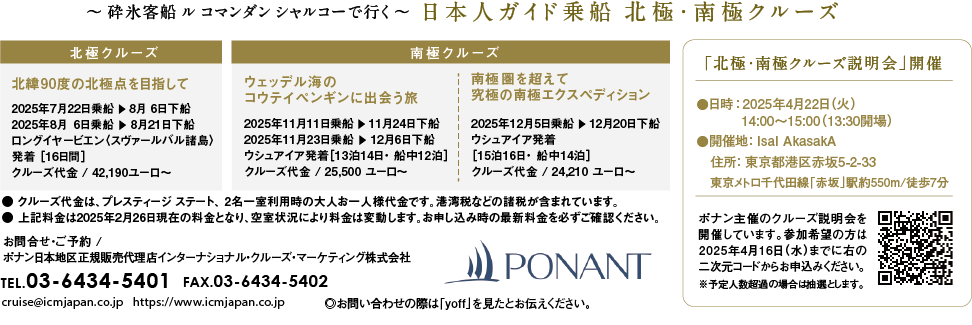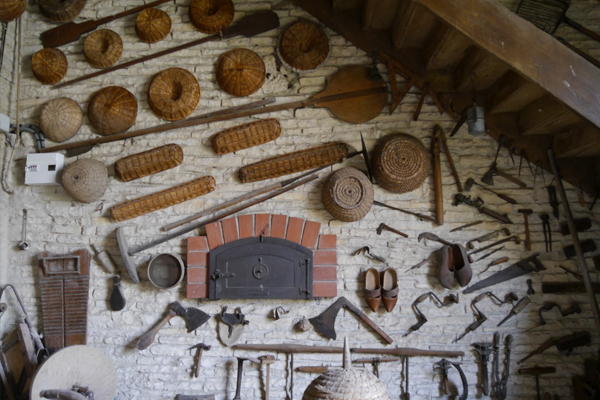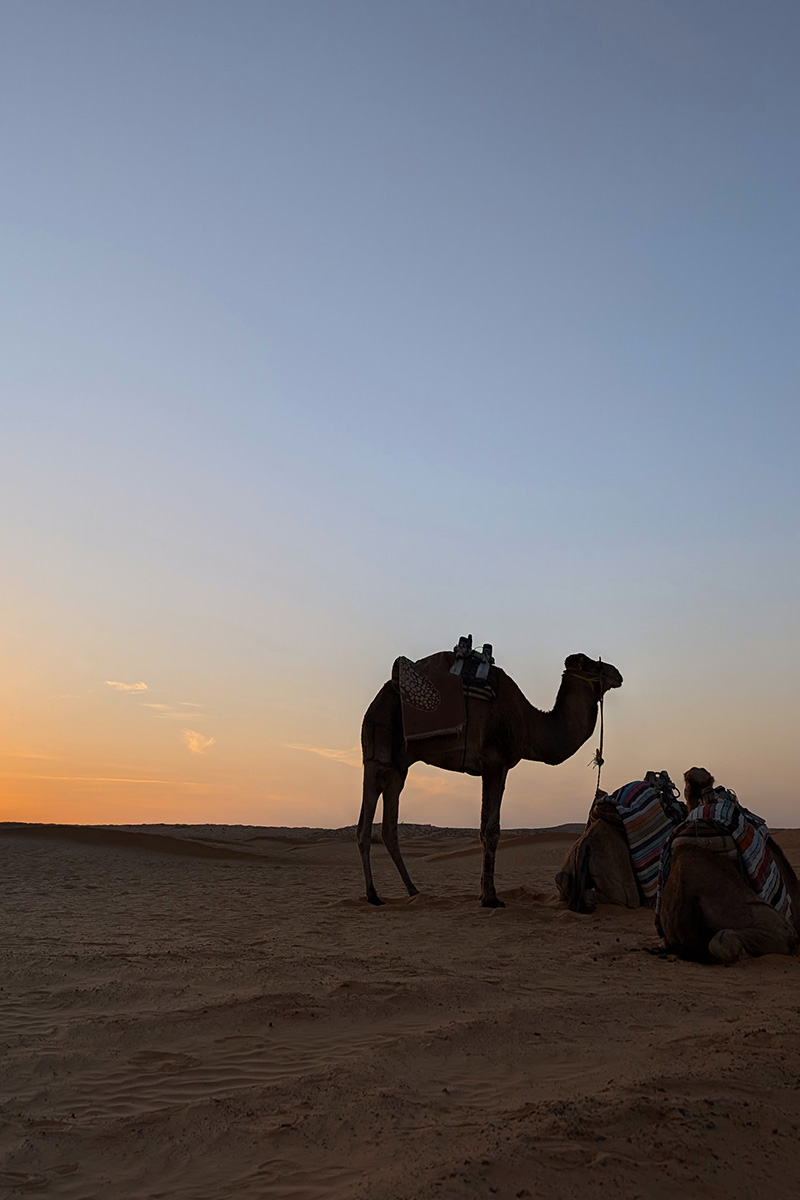
もっと、遠くへ!
もっと、遠くへ!
海外で知的好奇心を刺激されましょう、という話。

インバウンドは盛況なのに、海外へ行く人は減り、 日本人のパスポート保有率は6人に1人だという。 「書を捨てよ、町を出よう」は寺山修司の本のタイトルだが、 今は「ネットでの知ったつもりを捨てよ、 海外に出よう」と言いたい。 海の向こうにあるリアルな世界には、 知的好奇心があふれているのだから。 そんな思いから今号のyoffは「もっと、遠くへ!」という タイトルでアフリカ大陸の北にあるチュニジアを特集。 美しいイスラム装飾や 深い歴史・文化、砂漠の絶景に出会う旅。 この号を読んで、よし、自分も海外へ行くぞ!と なっていただけるとうれしいです。
もっと、遠くへ!
Feature | 2025.3.24
海外で知的好奇心を刺激されましょう、という話。
インバウンドは盛況なのに、海外へ行く人は減り、
日本人のパスポート保有率は6人に1人だという。
「書を捨てよ、町を出よう」は寺山修司の本のタイトルだが、
今は「ネットでの知ったつもりを捨てよ、
海外に出よう」と言いたい。
海の向こうにあるリアルな世界には、
知的好奇心があふれているのだから。
そんな思いから今号のyoffは「もっと、遠くへ!」という
タイトルでアフリカ大陸の北にあるチュニジアを特集。
美しいイスラム装飾や
深い歴史・文化、砂漠の絶景に出会う旅。
この号を読んで、よし、自分も海外へ行くぞ!と
なっていただけるとうれしいです。
A discussion
about sparking your intellectual curiosity abroad.
Despite the inbound tourism boom,
fewer Japanese are traveling abroad,
with only one in six holding a passport.
Shuji Terayama’s Throw Away Your Books,
Rally in the Streets could now be rephrased as
“Forget what you think you know online—go abroad!”
Because beyond the sea is a real world that will spark your intellectual curiosity.
With this in mind,
this issue of yoff titled “Venture Farther and Beyond!” features Tunisia,
a country in North Africa.
Explore its stunning Islamic artistry, rich history,
and breathtaking deserts.
May this issue inspire you to venture abroad!
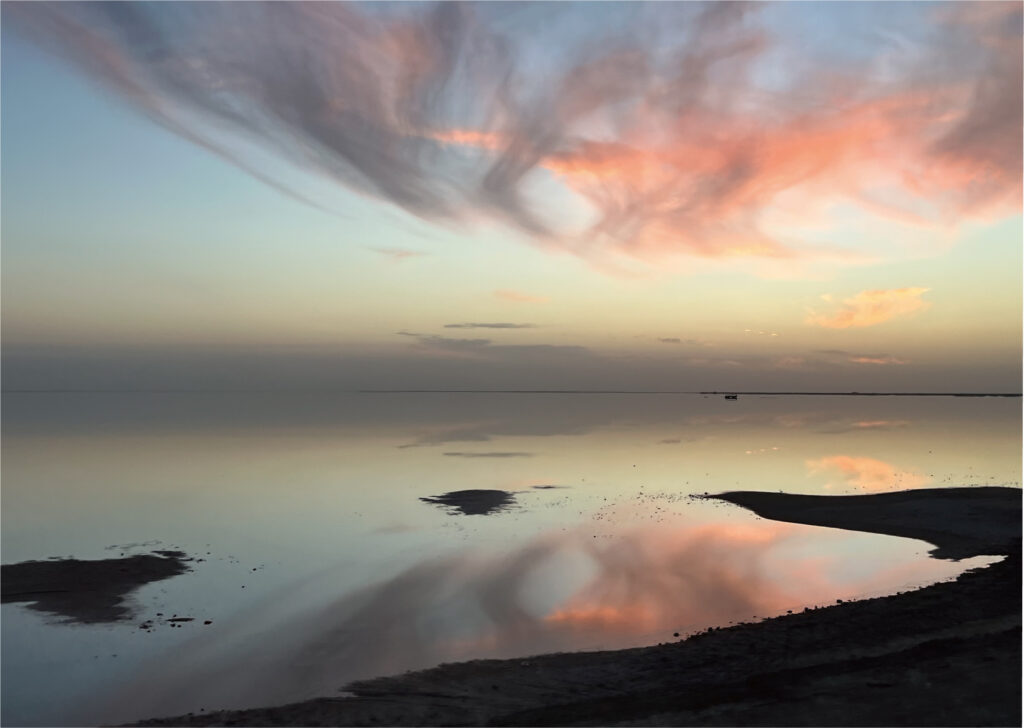
次はどこへ行こう、と思ったときから旅は始まっている。
未知の国へ、街へ。知らない風景のなかをどきどきしながら歩く歓び。
旅慣れた人ならアメリカやヨーロッパの街並みはもう知っている。
そこはそこで魅力だけど、どうせ行くなら知らないところがいい。
東南アジア、東欧、インド、中近東、アフリカと世界は大きく広がっている。
もっと、遠くへ!
初めての土地や文化、自然、そして人々と出会うために。
旅をつづけることで、人生は大きく広がっていく。
The journey begins the moment you ask, “Where to next?”
An unknown country, an unfamiliar city—the thrill of stepping into new landscapes.
For seasoned travelers, America and Europe may feel familiar.
While they have their charm, why not venture somewhere new?
The world is vast—Southeast Asia, Eastern Europe, India, the Middle East, Africa.
Venture farther and beyond!
Discover new lands, cultures, nature, and people.
With each journey, your world will grow in ways you never imagined.
もっと遠くへ行きたい。見知らぬ街を歩きたい。そう思いながら地図を眺めていると、気になる国が見つかった。それはチュニジア。
チュニジアと聞いてもピンとくる人はあまりいない。知っていたとしてもカルタゴ遺跡や、アラブの春、ジャスミン革命ぐらい。でも、ちょっと調べてみるとそこはとても魅力的な国。そもそもフランスの保護領で、言語はアラビア語チュニジア方言とともにフランス語が多く使われている。国民のほとんどがイスラム教徒で、街にはモスクがありミナレットが聳えている。そしてなんといってもここはアフリカ大陸で、地中海に面し、さらに砂漠もある。「イスラム」「アフリカ」「地中海」「砂漠」、この4つの言葉が旅したい気持ちを刺激する。青い空の下、地中海を背景に白い建物が並ぶ。ミナレットからはアザーンが聞こえ、頭にターバンを巻いた男性が通りを歩き、女性はヒジャブを被っている。街を外れるとナツメヤシの林があり、その向こうでサハラ砂漠はどこまでも広がり、ラクダたちが悠々と歩いている。これは行かずにはおれない。
さて、旅の手配だ。直行便はないのでドバイやトルコ、ヨーロッパでトランジットする。治安は良さそうだし、気候も日本と大差はなく、気をつけるとしたら砂漠での昼夜の気温差ぐらい。通貨はチュニジア・ディナール。円安の影響もそれほど受けていないようでひと安心。パリやニューヨークのように、一杯のラーメンが3000円もするような場所には行きたくない。どこをまわろうか。チュニジアは南北に長く、北は地中海に、南はサハラ砂漠に面している。ヨーロッパの人たちが訪れるリゾート地があり、ロマンあふれる遺跡があり、ベルベル人たちがいまでも暮らす横穴住居群があり、夕陽が沈む砂漠がある。どこもはずせない。せっかく遠くへ行くんだから、チュニジアをぐるっと一周、まわることにした。
I want to venture farther and beyond, to wander unfamiliar streets. As I scan the map for my next destination, one country stands out—Tunisia.
For many, Tunisia brings little to mind. Some may recall Carthage, the Arab Spring, or the Jasmine Revolution. But a quick search reveals a fascinating country. Once a French protectorate, Tunisia remains bilingual, with French spoken alongside Tunisian Arabic. The majority Muslim population fills the streets with mosques, their minarets piercing the sky. Above all, this is Africa—where the Mediterranean meets the desert. Islam, Africa, Mediterranean, desert—four words to stir a traveler’s soul. Whitewashed buildings line the coast beneath a brilliant blue sky. Calls to prayer echo from minarets, as turbaned men and hijab-clad women walk the streets. Beyond the city, date palms sway, giving way to the endless Sahara, where camels drift over golden dunes. I had to go.
Time to plan the journey. With no direct flights, I’ll need to transit in Dubai, Turkey, or somewhere in Europe. Security seems stable, and the climate is similar to Japan’s—except for the desert’s extreme temperature swings between day and night. The currency is the Tunisian dinar, and thankfully, the weak yen hasn’t affected the exchange rate much—that’s a relief. I have no interest in cities like Paris or New York, where a single bowl of ramen costs 3,000 yen.
Now, where to go? Tunisia stretches from the Mediterranean to the Sahara, offering a stunning contrast of landscapes. There are seaside resorts favored by Europeans, ancient ruins rich with history, underground Berber dwellings, and deserts painted in breathtaking sunset hues. I can’t miss any of it. Since I’ve come this far, I might as well go all the way—a grand tour of Tunisia it is.
カルタゴ〜ローマ〜アラブとつづくチュニジアで、歴史に浸る。
Feature | 2025.3.24

世界で6番目につくられた国、古代カルタゴが前身のチュニジア。
そこには深い歴史と文化が息づいている。
チュニジアの首都チュニスの近く、海に突き出た岬にフェニキア人たちの夢の跡、カルタゴ遺跡がある。フェニキア人は、エジプトなど東地中海からの様々なモノを西地中海の金や銀と交換し、それらをまた東地中海へ運ぶことで財を成した、古代地中海で活躍した商業民族。そんなフェニキア人の海上交易拠点となったのがカルタゴ。
フェニキア人たちはカルタゴに一大都市を築く。そこには紀元前7世紀から神殿や墓地があり、金属加工や陶器製造、染色などの工房が軒を連ね、街として発展していた。紀元前5世紀頃以降になると街路が碁盤の目に整備された、現代に繋がる都市計画に基づいた街づくりがされたという。そんな都市カルタゴも紀元前146年、ローマとの戦争に敗れ滅亡。そしてカルタゴ遺跡が残された。ここでは、当時のカルタゴの栄華を感じることができる。地中海を背景に、古代住居や共同浴場の跡を巡る。海風を受けながら、紀元前に想いを馳せる。
こうしてチュニジアはフェニキア人によるカルタゴの時代からローマ人に支配される時代になる。その頃を偲ぶ地が、チュニスから南西へ約100kmにあるドゥッガ。ここには紀元前46年にローマ支配下に入り、その後、ディオクレティアヌス帝の時代に繁栄した都市があった。いまドゥッガはアフリカ大陸最大のローマ古代都市遺跡となっている。
5000人とも1万人ともいわれる人々が暮らしていた街には、3階建ての大浴場や19段の客席があった劇場、神殿、さらには下水システムまで完備されていたといい、今でもその跡を目にすることができる。標高600mの丘の上というロケーションも相まって、スケールの大きな遺跡群がそこにいる人を圧倒する。神殿跡にそそり立つ数本の巨大な柱の前では、足が動かなくなった。こんなに迫力のある遺跡は、初めて見た。
カルタゴにもドゥッガにも、建物の壁面にモザイク画があった。当時の人物や風俗、動物、神話に登場する神などが描かれている。細かな石を敷き詰めて絵画のような表現をするモザイク画はフェニキア人の手によって描かれた。その後、ローマの時代にその技術は高められ、見事な作品が多く生まれたといわれている。そんなモザイク画がたっぷり鑑賞できるのが、チュニスにあるバルドー博物館。ここにはモザイク画の傑作とともに、イスラムのタイル模様、カルタゴ時代の石像などが集められている。
教科書のなかでは退屈だったものを、実際に目にして感動する。歴史の面白さをチュニジアが教えてくれた。
From Carthage to Rome to the Arab world,
a journey through layers of history.
Tunisia, home to ancient Carthage—one of the world’s oldest civilizations—is a land steeped in history and culture.
Near Tunisia’s capital, Tunis, on a promontory overlooking the sea, lie the ruins of Carthage—traces of the Phoenicians’ grand ambitions. The Phoenicians were seafaring traders who thrived in the ancient Mediterranean, amassing wealth by exchanging Eastern Mediterranean goods for Western gold and silver, then transporting their treasures back east. Carthage became one of their most vital maritime trade hubs.
The Phoenicians built a great city in Carthage. By the 7th century BCE, it had flourished into a bustling urban center with temples, cemeteries, and workshops for metalworking, pottery, and dyeing. By the 5th century BCE, the city adopted a grid layout—an early example of urban planning that still influences cities today. However, in 146 BCE, Carthage fell to Rome and was destroyed. Now, only ruins remain, yet the grandeur of ancient Carthage can still be felt. With the Mediterranean as a backdrop, visitors can explore remnants of ancient dwellings and communal baths. As the sea breeze brushes past, I let my thoughts drift back in time.
Tunisia transitioned from the Phoenician era of Carthage to Roman rule. One of the best-preserved sites from that time is Dougga, about 100 km southwest of Tunis.
Dougga came under Roman control in 46 BCE and later flourished during the reign of Emperor Diocletian. Today, it is the largest Roman archaeological site in Africa. Once home to an estimated 5,000 to 10,000 people, the city featured a three-story public bath, a theater with 19 rows of seating, temples, and even an advanced sewage system—traces of which remain today. Perched atop a 600-meter-high hill, the vast ruins command an overwhelming presence. Standing before the towering columns of a temple, I found myself frozen in awe—I had never seen ruins so powerful, so breathtaking.
Both Carthage and Dougga featured mosaic-adorned walls, depicting people, daily life, animals, and mythological gods. The Phoenicians introduced the art of mosaic—crafting intricate, painting-like images from tiny stones. Under Roman rule, the technique advanced, resulting in stunning masterpieces. For a full immersion in these mosaics, the Bardo Museum in Tunis is the place to visit. Alongside exquisite mosaics, it showcases Islamic tile patterns and Carthaginian stone statues.
What once felt dull in textbooks came to life before my eyes, leaving me deeply moved. Tunisia revealed the true excitement of history.


アフリカ最古のモスク、ケロアンの「グランドモスク」。 The Great Mosque of Kairouan, the oldest mosque in Africa.
青から朱へ、グラデーションに染まる風景を前にして立ちすくむ。
Feature | 2025.3.24

サハラ砂漠が夕陽に染まり、長い影を落としながらラクダが歩いている。
ずっと、この風景に出会いたかった。
南北に長いチュニジアは北部の地中海性気候から中部のステップ気候があり、そして南部の砂漠気候へと至る。砂漠気候といっても、そこには岩肌が剥きだしになった山が連なる岩石砂漠や石・砂利のなかにわずかな植物が見られる礰砂漠があり、その先にサハラ砂漠が広がる。
チュニジア南部にはオアシスが多くあり、そのなかでも最大規模のオアシスがトズールという街。ナツメヤシの林に囲まれた街には、日干しレンガの建物が並びエキゾチックな風景を見せている。南部観光のポイントにもなっていて、土産物店も多く、染め物や雑貨などを買い求める観光客で賑わっている。
トズールを抜けてさらに進むと砂漠の入口となる村、クサール・ギレン。ここまで来れば砂丘がうねり、風紋が彼方まで続く、いわゆる “本物の砂漠” が広がっている。思い出すのはその昔、映画「アラビアのロレンス」で見た、オマー・シャリフが登場するシーン。砂漠に揺らぐ陽炎のなか、遙か向こうから黒い影が近づいてくる。音楽もない、静かで、印象的な約2分間の長回し。このシーンを見てから憧れつづけてきた景色が今、目の前にある!
もちろんラクダに乗る。手綱を引いてくれるベルベル人のおじさんは陽気で愉快。いくつかの砂丘を越えて行った先で、ラクダからおりて大きく深呼吸をする。どこまでも見渡す限り砂漠。遠くへ来たという実感がわく。
クサール・ギレンでの宿泊はテントロッジがいい。テントといってもちゃんとベッドがあり、シャワーもエアコンも完備されていて快適。いまの日本でいうグランピングな感じ。
日が沈む頃、砂漠を散歩すると、きれいな夕陽が砂の海へ沈んでいき、うっとり。翌朝、日の出とともにまた砂漠へ。こんどは砂の海から昇る太陽を見て、またうっとり。時間とともに移ろう風景の色の他には、なんの変化もなく、あとは風が吹くくらい。ただただ静かに時が流れる、そんな砂漠に、心が奪われる。
砂漠へ行く途中にアフリカ最大の塩湖、ショット・エル・ジェリドに立ち寄った。ちょうど夕暮れ時。大きく真っ赤な太陽が塩湖へと沈んでいく。ボリビアのウユニ湖の映像でも有名なように、塩湖はその水面に周囲の風景を美しく映す。そしてここショット・エル・ジェリドに現れたのは、青から橙、そして朱色へと変化していく空と、それを鏡のように映す水面。天と地の境がなくなった、ただただ美しい色に包まれた景色は奇跡と呼ぶしかないほど神秘的。そして自分は呆然と、そこに立っているしかできなかった。
I stand transfixed before the landscape
where blue fades into vermillion.
The Sahara glows in the setting sun,as camels stride, casting long shadows.
I had dreamed of this moment.
Tunisia stretches from north to south, shifting from a Mediterranean climate to steppe, and finally to the arid deserts of the south. Even the desert landscapes vary—rocky deserts with jagged mountains, reg deserts where sparse vegetation clings to gravel and stone. Beyond them lies the boundless Sahara.
Southern Tunisia is dotted with oases, the largest being Tozeur. Surrounded by vast date palm groves, its sun-dried brick buildings create an exotic cityscape. A key stop on the southern travel circuit, the town is bustling with souvenir shops where visitors browse colorful textiles, handicrafts, and trinkets.
Beyond Tozeur lies Ksar Ghilane, a village at the edge of the desert. Here, dunes ripple endlessly, their wind-sculpted patterns stretching to the horizon—the “true desert.” I instantly recalled a scene from Lawrence of Arabia—Omar Sharif emerging through a shimmering heat haze, a lone silhouette in the vast expanse. A two-minute take, silent, powerful, unforgettable. For years, I had dreamed of this landscape—and now, it was right before my eyes!
Of course, I rode a camel. The Berber guide, cheerful and full of humor, led the way.
After crossing several dunes, I dismounted and took a deep breath. As far as the eye could see—nothing but desert. The realization sank in—I had truly come far.
For an overnight stay in Ksar Ghilane, a tented lodge is the perfect choice. But these are no ordinary tents—equipped with beds, showers, and even air conditioning, they offer unexpected comfort. It’s Tunisia’s take on glamping.
As the sun set, I wandered the desert, mesmerized by the golden sun sinking into a sea of sand. The next morning, at sunrise, I returned—this time, watching the sun rise from the dunes, captivated once again. Apart from the shifting hues, nothing changed—only the whisper of the wind across the sands. Time flowed silently, undisturbed. And in that stillness, the desert held me spellbound.
On the way to the desert, I stopped at Chott el Jerid, the largest salt lake in Africa. It was just around sunset. A massive, crimson sun sank into the lake. Like Bolivia’s Salar de Uyuni, the salt flats reflected the surrounding scenery with breathtaking clarity. At Chott el Jerid, the sky deepened from blue to orange, then vermilion—its colors mirrored perfectly on the lake’s surface, like a vast, luminous canvas. The boundary between heaven and earth vanished. Bathed in shifting color, the scene was nothing short of miraculous. All I could do was stand there, transfixed.

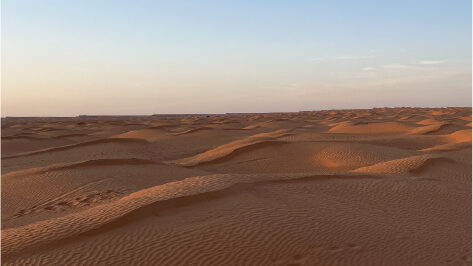
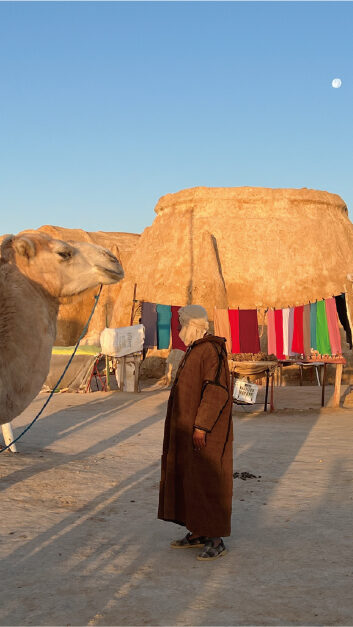
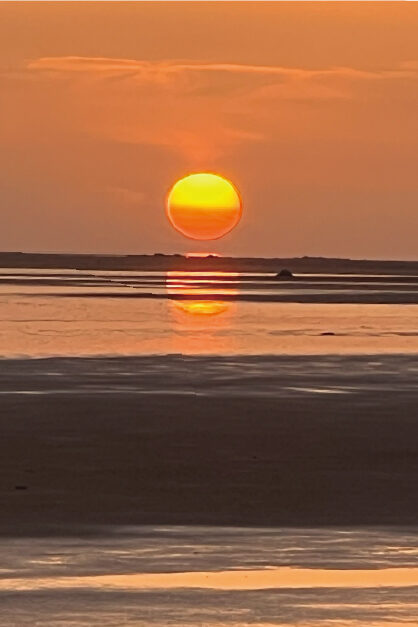
チュニジアブルーと白い壁がアーティストたちを誘う。
Feature | 2025.3.24

青と白の街に感性が刺激され、雑多でノイジーな街に心が躍る。
多彩こそがチュニジアの魅力。
「色彩の国」と形容されることが多いチュニジア。空の青、地中海の碧、砂漠に沈む夕陽の赤、広大なオリーブ畑の緑。たしかにチュニジアは色であふれている。それらに加えて印象的なのが、白とチュニジアブルーの建物が並ぶ街。なかでもシディ・ブ・サイドはチュニジアで最も美しいといわれている。1909年、この地に邸宅をかまえていたロドルフ・デルランジェ男爵が、自分が好きな白と青だけを使用するように強制し、無秩序な建築を禁止した。そしてここに、エキゾチックを絵に描いたような街並みができた。
チュニス湾とカルタゴを見下ろす丘の上にある、青と白にブーゲンビリアの赤が映える街。その景観は多くの芸術家を魅了した。小説家のギュスターヴ・フローベールやアンドレ・ポール・ギヨーム・ジッド、哲学者のシモーヌ・ド・ボーヴォワール、芸術家のパウル・クレー。思想史家であり哲学者のミシェル・フーコーはここで「知の考古学」を執筆した。
ちなみに、もうひとつの青と白の街であるスースは、あのソフィア・ローレンが愛した街だという。この色合い、この風景、この空気感がアーティストの感性を刺激する。
アートな街がある一方、猥雑さが楽しい街もある。例えば、チュニスのスーク(市場)。いくつもの小路が迷路のように入り組み、雑貨屋や洋品店、土産物店などがぎっしり並んでいる。狭い通路に多くの人が行き交う様はエネルギッシュ。歩き疲れたらカフェで休憩。耳慣れない言葉が飛び交う喧噪のなかでミントティーを飲めば、すっかりチュニジアに溶け込んだ気分になる。
チュニジアの魅力はまだまだある。人が親切でチャーミング、食事がどれもあっさりしていて食べやすく美味しい、そして1日に5回あるイスラム礼拝の前に街に鳴り渡るアザーンに心が揺さぶられる、などなど。
もっと遠くへ行きたいと思ってやってきて、旅が終わってみたらまた行きたいと思う、それがチュニジア。
Tunisia’s blue and white walls beckon artists.
In the blue-and-white town, my senses awaken. In the bustling, noisy streets,
my heart dances. Diversity is Tunisia’s true charm.
Tunisia is often called the “land of colors.” The deep blue sky, turquoise Mediterranean, fiery desert sunsets, and vast olive groves—a country alive with color. Among its most striking sights are towns of white buildings accented by Tunisia’s signature blue. The most beautiful of them all is Sidi Bou Said. In 1909, Baron Rodolphe d’Erlanger, who made his home here, decreed that only his favorite colors—white and blue—be used, banning chaotic architecture. And so, an exquisitely picturesque town was born.
Perched on a hill overlooking the Bay of Tunis and Carthage, this blue-and-white town is further adorned by the vibrant red of bougainvillea. Its beauty has captivated countless artists. Writers like Gustave Flaubert and André Gide, philosophers such as Simone de Beauvoir, and artists like Paul Klee all found inspiration here. Michel Foucault, the historian and philosopher, even wrote The Archaeology of Knowledge in this very town. Meanwhile, another blue-and-white town, Sousse, was beloved by none other than Sophia Loren. This palette, this scenery, this atmosphere—all of it stirs the artist’s soul.
Yet, alongside these artistic havens, there are also chaotic, vibrant cities pulsing with life. Take, for instance, the souks of Tunis—labyrinths of narrow alleyways crammed with shops selling trinkets, clothing, and souvenirs, a dazzling sensory overload. The packed passageways, teeming with people, radiate infectious energy. When exhaustion sets in, a café break is in order. Sipping mint tea amid the clamor of unfamiliar voices, I felt myself dissolve into the rhythm of Tunisia.
And still, Tunisia has more to offer. Its people—warm and full of charm. Its cuisine—light, flavorful, effortlessly delicious. The haunting calls to prayer—echoing across the city five times a day, stirring the soul.
I came seeking a journey to take me far. Yet by the time it ended, all I wanted was to return to Tunisia.


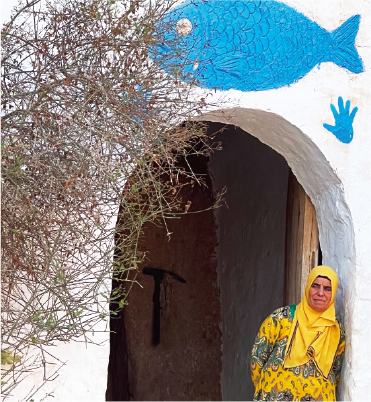
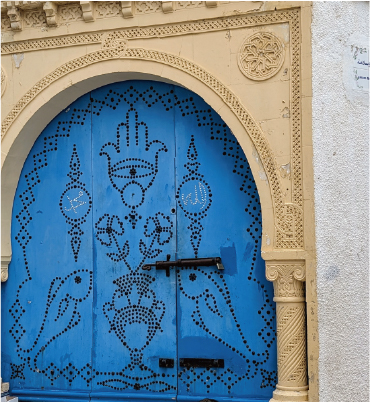
アハメド・シャフラ 駐日チュニジア共和国大使
Ahmed CHAFRA Ambassador of the Republic of Tunisia to Japan
チュニジアは、豊かな文化遺産、美しい地中海ビーチ、そして息を呑むような砂漠の風景を提供する国です。訪問者は、カルタゴ、ドゥッガ、チュニスのメディナなどのユネスコ世界遺産を探索できます。一方、サハラ砂漠では、ラクダトレッキングや、映画「スターウォーズ」で有名になったマトラタの地下住居などのユニークな場所への訪問といった冒険の機会が提供されています。ハマメットやジェルバ島などの沿岸部の目的地は、手つかずのビーチと豪華なリゾートで観光客を魅了し、自然愛好家はイシュケル国立公園やショット・エル・ジェリドの印象的な塩湖を訪れることができます。
この素晴らしい遺産を世界と共有するため、チュニジアは誇りを持って2025年大阪万博に参加し、その活気に満ちた歴史、観光の可能性、そして投資機会を紹介するユニークな場を提供します。4月13日から10月13日まで、日本の皆様をチュニジア館へ温かくお迎えし、チュニジアの真髄、その有名な美食、そして深い文化的つながりを体験していただきたいと思います。皆様のお越しを心よりお待ちしております!
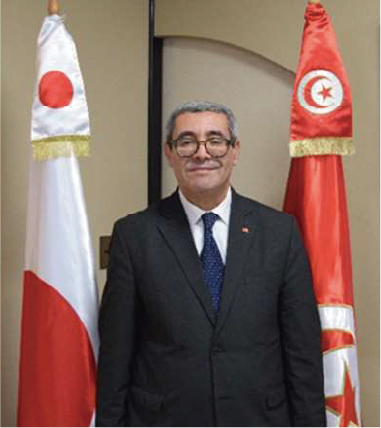
Tunisia offers a rich mix of cultural heritage, stunning Mediterranean beaches, and breathtaking desert landscapes. Visitors can explore UNESCO World Heritage Sites like Carthage, Dougga, and the Medina of Tunis, while the Sahara Desert provides adventure opportunities such as camel treks and visits to unique sites like the underground houses of Matmata, famously featured in Star Wars. Coastal destinations like Hammamet and Djerba attract tourists with their pristine beaches and luxury resorts, while nature lovers can visit Ichkeul National Park and the striking salt flats of Chott el Jerid.
To share this remarkable heritage with the world, Tunisia will proudly take part in Expo 2025 Osaka, providing a unique platform to showcase its vibrant history, tourism potential, and investment opportunities. We warmly invite our Japanese friends to visit the Tunisian Pavilion from April 13 to October 13, where they can experience the essence of Tunisia, its renowned gastronomy, and its deep cultural connections. We look forward to welcoming you!

パックツアーを利用して “もっと、遠くへ!”。行きたい国がぐんと増えた
Feature | 2025.3.24
初めてパックツアーに参加してみたら、
もっと早く利用しておけば良かったと反省。
これなら難しいと思っていた辺境の地へも行けそうだ。
Using package tours, venture farther and beyond!
Now I want to visit many more countries.
After joining a package tour for the first time, I regretted not doing it sooner. Such tours make it possible to visit remote places . I once thought were out of reach.

もっと、遠くへ行こう!とチュニジアを一周することにした。でも、日本を留守にできるのは2週間。チュニジアは鉄道網が発達しているとはいえず、バスも心許ない。しかも、言葉がアラビア語かフランス語なので、道中いろいろと問題が起きることは必至。はたして周りきれるだろうか。そうしていろいろ考えて、今回はパックツアーに申し込むことにした。
知らない人とぞろぞろ歩き、一日の行程も食事も決まっている。そんな不自由さからこれまでは敬遠してきたパックツアー。 しかし、いざ旅立ってみると、これがすこぶる快適だった。
現地では、スーツケースを転がして歩く必要なし。朝、ホテルの部屋の前に出しておけばバスまで運んでくれる。移動はすべてバスなので、電車のチケットを取る心配もない。博物館や美術館などの入場も気にすることなし。食事はどれも美味しかったし、事前にいえばパスすることもできる。添乗員さんもガイドさんも有能で、同行の人たちもいい人ばかり。2日目くらいからすっかりパックツアーの仲間たちのひとりになっていた。いや、ホントにラクで楽しくて驚いた。ここまで手厚いサービスができる旅行会社に興味がわき、今回のツアーをお願いしたユーラシア旅行社さんを訪問。そこで開発部エグゼクティブディレクターの上野 宏さんが話を聞かせてくれた。
Wanting to venture farther and beyond, I set out on a grand tour of Tunisia. But with only two weeks away from Japan, I had my concerns. Tunisia’s railway network is limited, bus services are unreliable, and the language barrier—Arabic and French—would surely pose challenges. Could I really navigate the entire country? After considering it all, I decided to book a package tour.
I had always avoided them—following a group, sticking to a set itinerary, eating prearranged meals. It all felt too restrictive, so I dismissed package tours as not for me. Yet, once the journey began, I was amazed at how incredibly comfortable it was.
No more lugging my suitcase through the streets—just leave it outside my hotel room, and it would be delivered straight to the bus. All transportation was by bus, eliminating the hassle of securing train tickets. Museum and gallery admissions? Already taken care of. The food was delicious, and I could even opt out of meals in advance. Both the tour guide and local guide were highly competent, and my fellow travelers turned out to be genuinely pleasant company. By the second day, I had fully settled into my role as one of the group. Honestly, I was shocked—this was easy and far more fun than I had expected. Curious about the travel company behind such exceptional service, I decided to visit Eurasia Travel Agency, the organizer of my tour. There, I spoke with Hiroshi Ueno, Executive Director of the Development Department.

チベットの大自然を旅するパックツアーもある。

パンタナールなどブラジルの絶景へ。
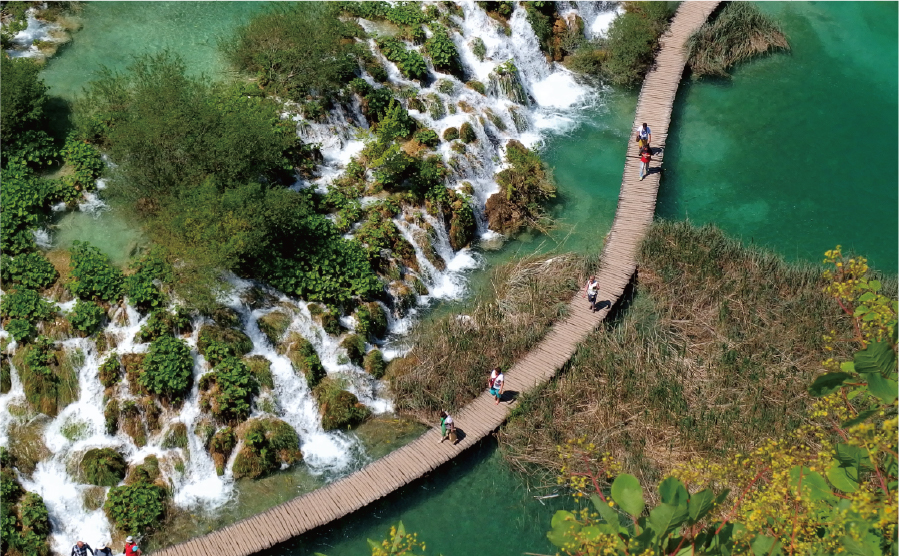
ザグレブ、ドゥブロブニクなどクロアチアを巡る旅。

サハラ砂漠を満喫!モロッコ旅行。
写真提供:ユーラシア旅行社
「旅行会社は海外の手配は手配会社にお願いします。手配会社には主に2種類あり、1つは日本の旅行会社の支店や日本に拠点をもっている大手、もう1つは現地の旅行会社で、チュニジアならチュニジア、モロッコならモロッコの会社です。現地の会社は、自分の国の良いところを知ってもらおうと頑張ります。旅行に対する熱量が違うので、より良い旅程やホテル、レストランを手配してくれます。弊社では主に現地の手配会社を選び、付き合いを大切にしています。いざという時も頼りになります」。
添乗員さんも優秀でした。 「 ユーラシア旅行社では、『旅は添乗員次第』 という言葉を胸に、知識やトラブル対処能力は勿論、豊かな旅の実現に精一杯尽くせる人柄が重要だと考えています。最も大切なのは安全・安心で、会社もそれを支え、添乗員も安心して添乗業務に打ち込めます」。
ツアーに参加している人たちともすぐに打ち解けました。「弊社では、旅の価値を決定するのは、まず添乗員、次に『良き旅仲間』と記載しています。見知らぬ人同士が何日も時間と空間を共有するので、例えば、時間厳守であったりバスの座席のローテーションであったりと、皆が気持ちよく過ごせるようにお客様にお願いをしています。また、こうしてお客様同士の『和』が、いざという時、飛行機の遅れや体調を崩した方がでたときでも、スムーズに対応でき、結果としてよい旅となります」。
これから、どんなツアーをつくっていきたいですか。「我々は世界170ヵ国をあつかい、治安が落ち着けばアフガニスタンやイラクは素敵な遺跡がたくさんあります。ウクライナも戦争前はたくさんのツアーが出ていました。平和になって欲しいですね。又、見るだけでなく体験する旅、ワイン発祥の地で葡萄を収穫するとか。あと、専門家の方と行く旅なんかも感動があります。もっともっと面白い旅が溢れ出てきます」。
これから先、パックツアーを利用することが増えそうだ。
“Travel agencies rely on local booking companies for overseas arrangements,” he explained. “There are two main types: one is a branch office of a Japanese travel agency or a major company with a base in Japan. The other is a local travel agency—so in Tunisia, it would be a Tunisian company, in Morocco, a Moroccan one. Local companies are passionate about showcasing the best of their own country. Their enthusiasm for travel is on another level, allowing them to secure better itineraries, hotels, and restaurants. At our company, we prioritize working with these local booking agencies and building strong relationships with them. They’re also invaluable in case of emergencies.” The tour conductor on my trip was exceptional. “There’s a saying: ‘A trip is only as good as its tour conductor.’ Knowledge and problem-solving skills are essential, but so is a warm personality that enhances the journey. Above all, safety comes first, and our company ensures conductors can focus entirely on their duties.”
I also quickly bonded with my fellow travelers.
“They say a great journey depends first on the tour conductor and second on good travel companions. Since strangers spend days together, we ask for consideration—being punctual, rotating bus seats—to ensure a comfortable experience for all. This camaraderie also proves invaluable in unexpected situations, like flight delays or illness, helping the trip run smoothly.”I asked about future tour plans. “If security improves, Afghanistan and Iraq, with their incredible ruins, would be fantastic destinations. Before the war, Ukraine was also popular—I truly hope for peace. I’d love to offer more immersive experiences, like harvesting grapes in the birthplace of wine. Journeys with specialists, traveling alongside experts, can be deeply moving. The possibilities for fascinating journeys are endless.”
I also quickly bonded with my fellow travelers.
“They say a great journey depends first on the tour conductor and second on good travel companions. Since strangers spend days together, we ask for consideration—being punctual, rotating bus seats—to ensure a comfortable experience for all. This camaraderie also proves invaluable in unexpected situations, like flight delays or illness, helping the trip run smoothly.”I asked about future tour plans. “If security improves, Afghanistan and Iraq, with their incredible ruins, would be fantastic destinations. Before the war, Ukraine was also popular—I truly hope for peace. I’d love to offer more immersive experiences, like harvesting grapes in the birthplace of wine. Journeys with specialists, traveling alongside experts, can be deeply moving. The possibilities for fascinating journeys are endless.”
I’ll likely be taking more package tours from now on.

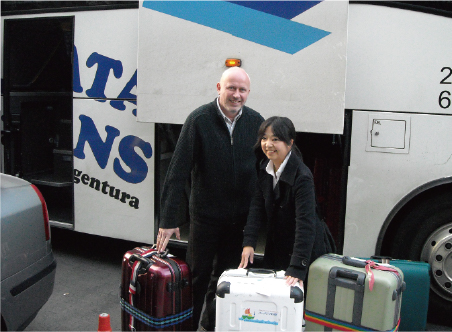
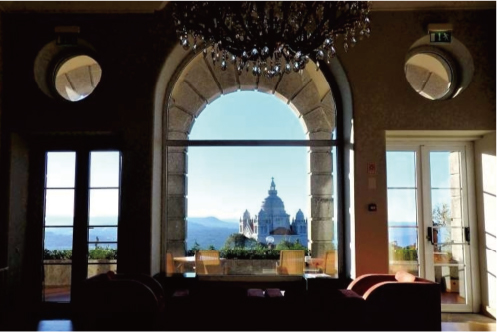
「少人数で快適」「バスは大型が中心」「土産物店の立ち寄りなし」「主要都市ホテルは概ね4つ星クラスか上質クラス」など価値あるツアーを届けてくれる。

欧州はもちろん、南米、アフリカ、中近東から日本国内のツアーまで手がける。
他にはないようなユニークな企画が多くある旅行会社。
www.eurasia.co.jp

[PR]知的好奇心に誘われて、北極へ、南極へ。
Feature | 2025.3.24
未知なる景色に出会うためにも、
行けるうちに行っておきたい場所がある、
海の上を優雅に往くラグジュアリーな砕氷船に乗って極地へ。
Out of intellectual curiosity,
I set my sights on the Arctic and the Antarctic.
To witness landscapes yet unseen,there are places I must visit while I still can.
Aboard a luxurious icebreaker gliding across the sea, I set out for the polar regions.
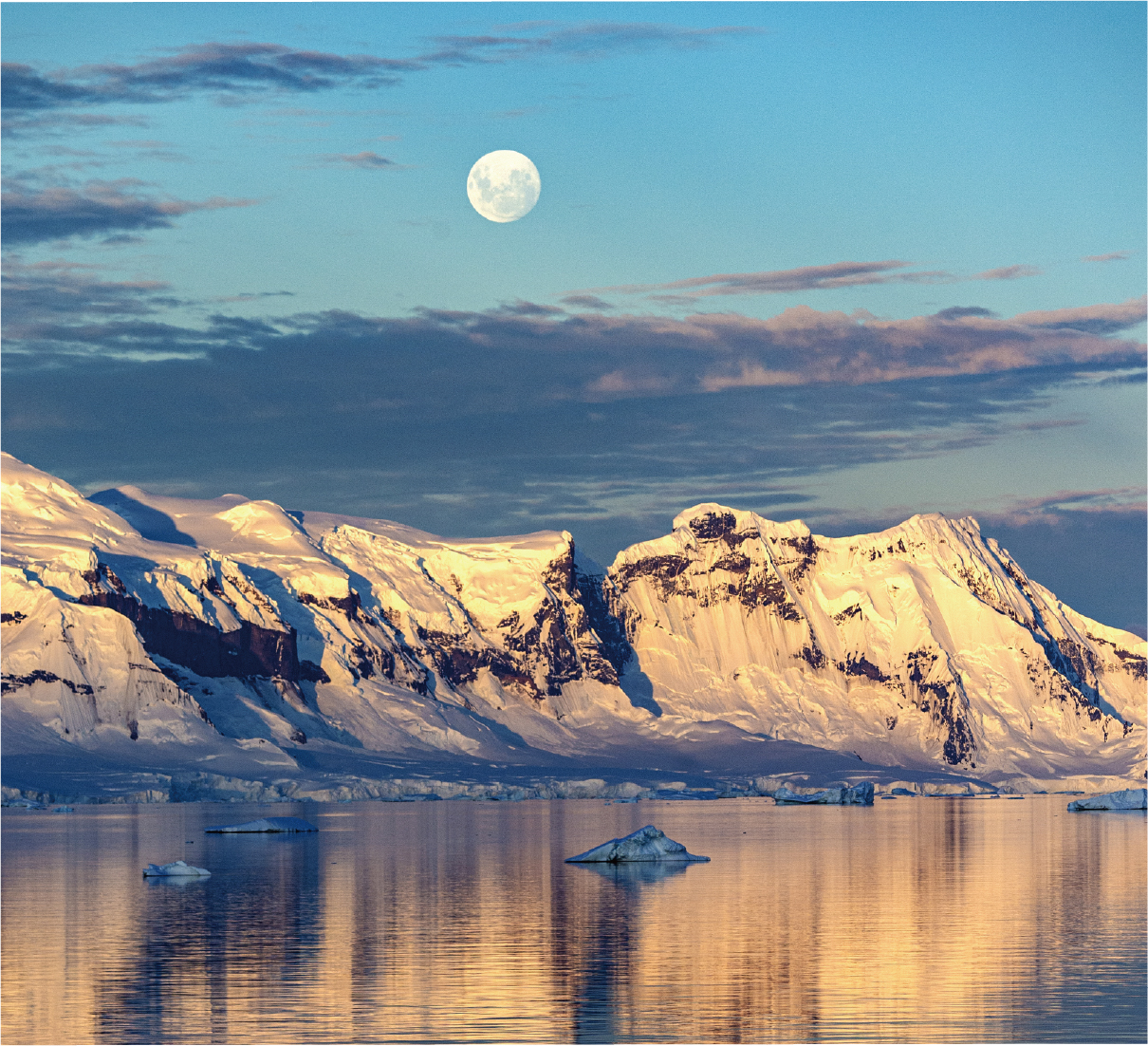
地球を感じる雄大な景色に出会いたくって、人は冒険家になる。

「もっと、遠くへ!」の最高峰はなんといっても極地、南極と北極だろう。
南極では雄大な氷河を背景にペンギンたちがよちよち歩き、その隣ではゾウアザラシが咆哮をあげている。ときにはクジラが海面に跳ね上がるブリーチングが見られるかもしれない。子どもの頃に読んだ、探検家アムンセンの物語にあったワクワクとトキメキにあふれたシーンが展開されている。
もう一方の極地が北極。北極圏にはアラスカやグリーンランド、アイスランドといった国があり、人々は極寒のなかに暮らしている。イヌイットを乗せて雪原を走る犬ぞり、雪が積もる森をヘラジカが悠然と歩き、ホッキョクグマは氷上から海へとダイブする。海上を進むと巨大な氷山に出くわす。海氷に閉ざされた世界ではときおり、氷がひび割れるときの張り詰めた音が響く。そしてあとは、ただ静か。そこは静寂に支配された、まるで時間が止まったような場所。
人間は冒険をする。未知への好奇心には抑えがたいものがある。そしてその冒険は、自分にもできる。行けるうちに行っておくべき、それが北極・南極。さいわいにも、温暖化やオーバーツーリズム、過剰な経済活動の影響は、まだここまではあまり届いていない。
地球儀の真上か真下へ、冒険心が誘っている。
「もっと、これ以上ない遠くへ!」と。
The desire to see Earth’s vast awe-inspiring landscapes is what makes adventurers.
For those seeking to venture farther and beyond, the ultimate destination is the polar regions—Antarctica and the Arctic.
In Antarctica, penguins waddle across the ice against towering glaciers, while elephant seals roar into the frozen air. If lucky, you might see a whale breaching the ocean’s surface. It’s a world straight from Roald Amundsen’s stories, evoking the same thrill and wonder I felt as a child reading about his adventures.
At the other end of the Earth lies the Arctic, stretching across Alaska, Greenland, and Iceland. This frozen world is home to people adapted to life in extreme cold. A dog sled glides through the snow, carrying an Inuit guide. A moose strides through a snow-covered forest. A polar bear plunges from the ice into the frigid sea.Sailing Arctic waters, one encounters towering icebergs, shimmering in shades of blue. In this world, where the sea lies frozen beneath thick ice, deep, resonant cracks echo as it fractures. And then—nothing. Just silence. A place where time itself seems to stand still, ruled by absolute tranquility.
Humans are drawn to adventure, unable to resist the call of the unknown. And this journey is within my reach. If ever there was a time to go, it is now. The Arctic and Antarctica are waiting.
Fortunately, these remote regions remain largely untouched by climate change, over-tourism, and excessive economic activity—at least for now.
At the very top and bottom of the world, adventure beckons.
Venture farther and beyond!
スタイリッシュな現代の冒険家は優雅な船旅で南極・北極へ。
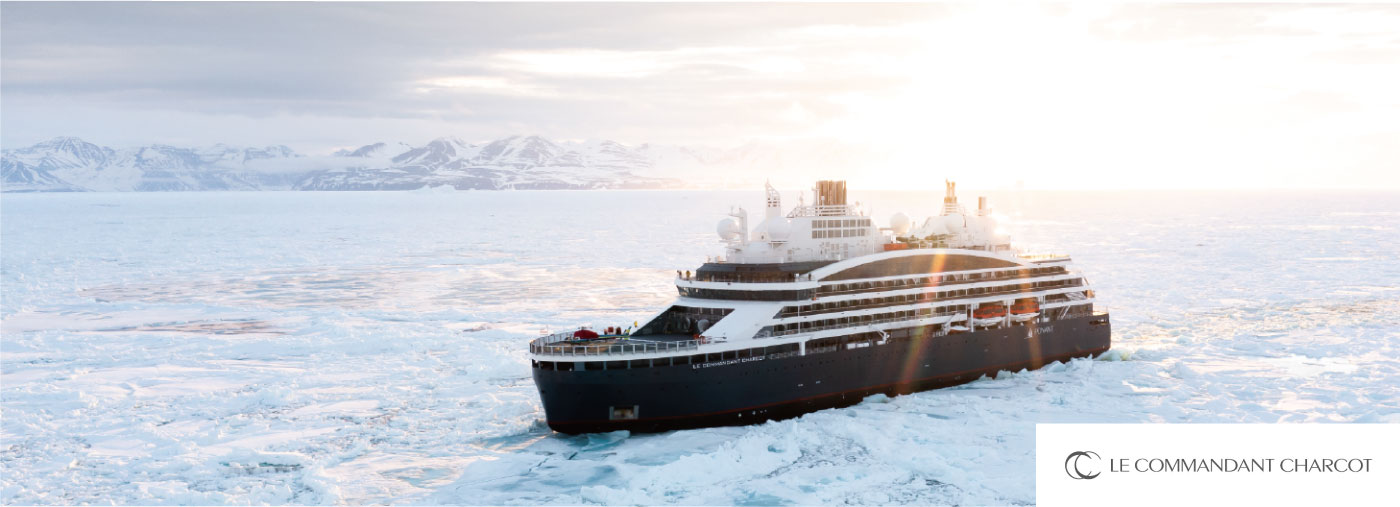


極地へとスマートな旅ができる船がある。世界唯一のラグジュアリー砕氷船「ル コマンダン シャルコー」。砕氷船だからこれまでの耐氷船ではたどり着けなかった場所へも行ける、まさに極地のための豪華客船。
船内はゴージャスを絵に描いたよう。ゆったりと寛げるラウンジがあり、レストランではアラン・デュカスが監修した料理が味わえる。アフタヌーンティーはピエール・エルメのマカロンとパルデラの紅茶で優雅に。もちろんプールデッキも用意されている。フランスの老舗サロンによるスパとサウナ、極上のエンターテイメントが繰り広げられるシアター、最新の機器が揃ったフィットネスルームも完備。船内のインテリアはフランスのエスプリが効いたスタイリッシュなデザイン。上質な美意識に包まれての船旅が楽しめる。
Stylish modern adventurers travel to the North and South Poles on elegant ships.
A new era of sophisticated polar travel has arrived. Introducing Le Commandant Charcot, the world’s only luxury icebreaker. Unlike conventional ice-strengthened ships, it can venture into previously unreachable destinations—a true luxury expedition vessel built for the extremes.
The ship’s interior is the epitome of luxury. A spacious lounge invites guests to unwind, while the restaurant offers a dining experience curated by Alain Ducasse. Afternoon tea features Ladurée macarons and Palais des Thés’ finest selection. Of course, there is also a pool deck. The onboard experience is further enhanced by a spa and sauna operated by a prestigious French salon, a state-of-the-art fitness center, and a theater showcasing world-class entertainment. Every inch of the interior exudes refined French sophistication, ensuring a voyage of elegance and impeccable taste.
フランス流のおもてなしと日本人ガイドがエスコート。


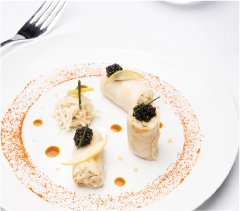

優雅に、ファッショナブルに、現代の冒険家を南極や北極へと案内するのは、フランス流のラグジュアリーとおもてなしで、世界のあらゆる海へとクルーズしている「PONANT」。極地への旅の他に、特徴的なのがベネチアでの停泊。ベネチアでは25,000t以上のクルーズ船は停泊できないが「PONANT」は停泊でき、乗客はゆっくりと水の都を楽しめる。そのことなどからも「PONANT」はワールドクラスのクルーズブランドとなっている。そんな「PONANT」では日本人ガイドが乗船したクルーズも実施。安心して「ル コマンダン シャルコー」に乗船して南極や北極への、優雅な冒険旅行に出かけられる。
A French-style host and Japanese guides at your service.
With elegance and style, modern adventurers set sail for Antarctica and the Arctic, guided by Ponant, where French luxury and hospitality meet exploration. Beyond polar expeditions, Ponant holds a rare privilege—access to Venice, where most cruise ships over 25,000 tons are banned. This exclusivity reflects its esteemed reputation across Europe and beyond. Today, Ponant stands as a world-class luxury cruise brand.
For added comfort, Ponant offers cruises with Japanese-speaking guides onboard. With every detail taken care of, guests can embark on an elegant expedition to the polar regions aboard Le Commandant Charcot with complete peace of mind.
広告
[PR]プリンスホテルにある、ホテルの憧れ。
Feature | 2025.3.24
ホテルが増えている今だからこそ、
きちんとホテルのことを考えたい。
私たちがホテルに求めているものは何か、と。
ホスピタリティ、非日常性、寛ぎ、そしてステイタス。
そんなときに「ザ・プリンス 軽井沢」のリニューアルを知った。
さて、どんなホテルになっているんだろう。
The epitome of hotel luxury at Prince Hotel.
With hotels more numerous than ever, now is the time to reflect on what a hotel should be. What do we seek? Hospitality, escape, relaxation, and prestige.
It was then that I learned about the renovation of The Prince Karuizawa. What kind of hotel has it become?
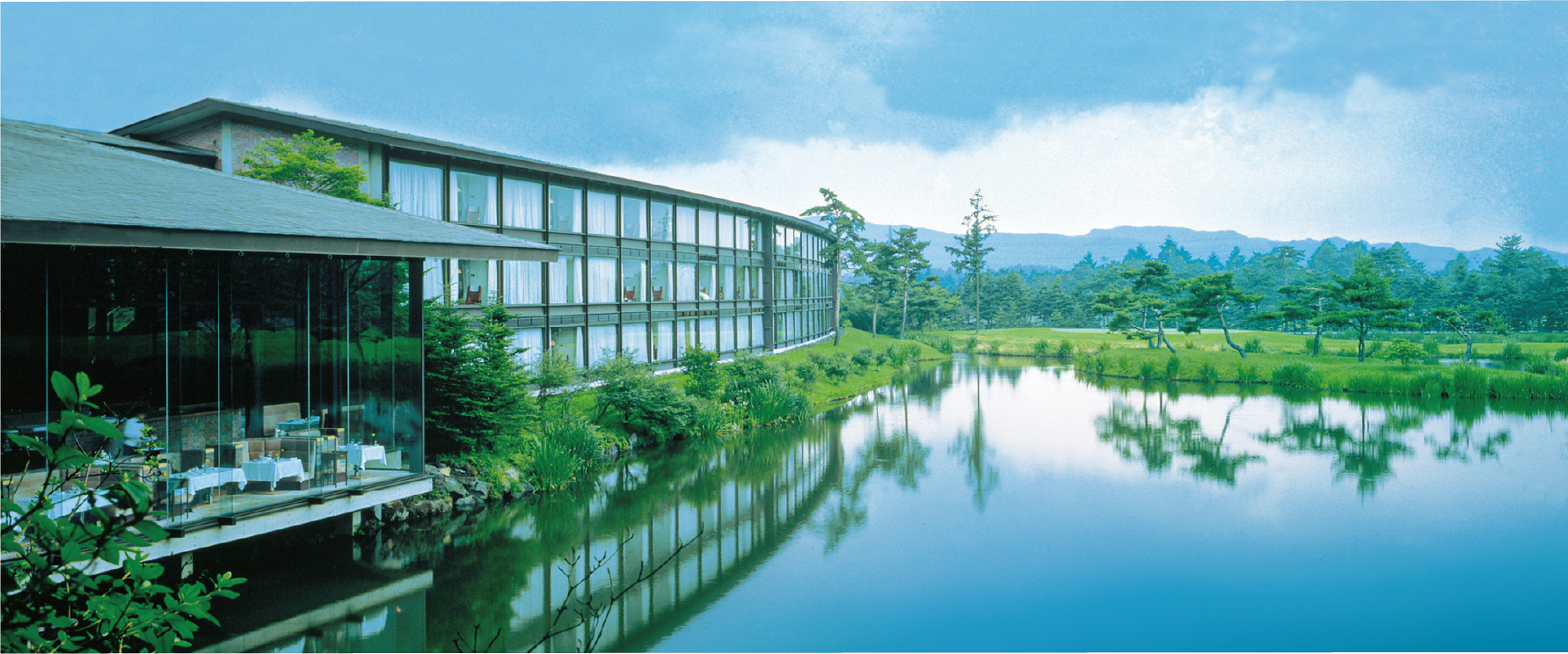
外観
由緒と格式が息づく、
当時のセレブたちも憧れたプリンスホテル。
日本を代表するリゾート、軽井沢。避暑地として、また四季それぞれの美しさに出会える場所として、多くの人たちから愛されてきた土地。そんな軽井沢のメインとなる場所に「プリンスグランドリゾート軽井沢」がある。
プリンスホテルの歴史はここ軽井沢から始まっている。もともと千ヶ滝地区にあった皇族・朝香宮家の別荘を改装し、1947年にホテルとしてオープン。その際に「プリンス・ホテル」と命名され、セレブたちの憧れとなった。そして1982年、南軽井沢に「軽井沢プリンスホテル新館(現ザ・プリンス 軽井沢)」がオープンして今に至る。設計したのは戦後日本の住宅建築の基礎を築いたといわれる清家清。由緒ある地に生まれた名建築家によるホテルだった。
A hotel steeped in heritage and tradition—one that even the elite of its time aspired to experience.
Karuizawa—Japan’s premier resort destination, long cherished as a summer retreat and a place to experience all four seasons, is home to Prince Grand Resort Karuizawa, the heart of this idyllic setting.
The legacy of Prince Hotel began in Karuizawa. In 1947, a villa belonging to the imperial Asaka family in Sengataki was transformed into Prince Hotel, quickly becoming a coveted retreat for the elite. In 1982, Karuizawa Prince Hotel Shinkan (now The Prince Karuizawa) opened in South Karuizawa, carrying the legacy forward. The original Karuizawa Prince Hotel was designed by Kiyoshi Seike, a pioneering architect who shaped postwar Japanese residential architecture—a hotel by a master architect in a location rich with history and prestige.
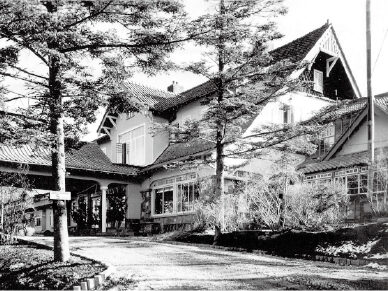
プリンス・ホテル

晴山ホテル
いつかは泊まってみたい、
あの「ザ・プリンス 軽井沢」が新しくなる。
日本のホテルブランドの先駆けとなり、そこにある歴史と由緒、そして格式を継承してきた「軽井沢プリンスホテル」。今では「プリンスグランドリゾート軽井沢」と呼ばれ、4つのホテルと2つの会員制ホテル、8つのゴルフ場、さらにショッピングモールなどもある一大リゾートエリアになっている。そんな「プリンスグランドリゾート軽井沢」にあるホテルのフラッグシップ「ザ・プリンス 軽井沢」がリニューアル。 2025年7月に全館フルオープンする。
「ザ・プリンス 軽井沢」といえば池畔に佇む姿が印象的。客室では窓外に池畔越しのゴルフコースが広がり、その向こうに浅間山を望む絶景が楽しめる。軽井沢に来たら一度は泊まってみたいと、多くの人が思うホテルだ。
The iconic The Prince Karuizawa, a hotel many dream of staying at someday,
is entering a new era.
As a pioneer among Japanese hotel brands, Karuizawa Prince Hotel has upheld a legacy of history, prestige, and refinement. Today, it is known as Prince Grand Resort Karuizawa, a vast resort encompassing four hotels, two exclusive membership hotels, eight golf courses, and a shopping mall. Now, its flagship hotel, The Prince Karuizawa, is undergoing a full-scale renovation and is set to fully reopen in July 2025.
The Prince Karuizawa is renowned for its stunning lakeside setting. Guest rooms offer sweeping views that stretch beyond the tranquil waters to the golf course, with the majestic Mt. Asama in the distance. For many, this is the ultimate hotel experience in Karuizawa.
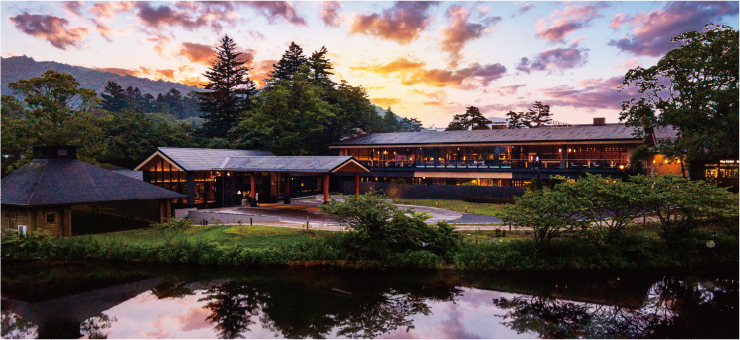
軽井沢プリンスホテル ウエスト外観
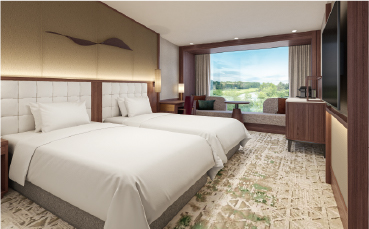
【リニューアル】 3階客室 (完成イメージ)

宿泊者専用ラウンジ(完成イメージ)
※客室とラウンジのリニューアルは2025年4月10日〜7月中旬にかけて順次オープン予定。
フィットネスは2025年7月中旬オープン予定。
浅間山を見渡す、静寂を楽しむ。
客室にさらなる開放感と
心地いい汗が流せるフィットネスも。
今回のリニューアルではまず、1〜3階の計65室を刷新。ゴルフ場と浅間山を望むピクチャーウインドウを生かし、3階客室の窓際にはデイベッドを新設する。目覚めたときから緑にあふれた大らかな風景に包まれることができる、朝が楽しみな部屋になりそうだ。また壁紙や絨毯、家具も新調。まっさらな部屋で自然とともに寛げる空間が生まれる。
リニューアルは他にもある。3階フロアとスイートルーム宿泊者の専用ラウンジを3階に新設。落ち着いた設えのなかでドリンクや軽食が楽しめる。
1階には外廊下から直結するフィットネスが誕生。約80㎡の空間で、最新のマシンを使い、汗を流しリフレッシュできる。日々、健やかな心身づくりを心がけている現代人には、こういったフィットネススタジオは欠かせない。
ホテルのダイニングであるフレンチレストラン「ダイニングルーム ボーセジュール」とロビーも昨年の12月にリニューアル。クラス感ある食と迎賓の空間が生まれた。
さらに嬉しいことに、リゾート内の「晴山ゴルフ場」も昨夏リニューアル。 坂茂設計のクラブハウスや嶋村唯史監修のコースなどで軽井沢の “開かれた社交場” になっているという。
Gaze out over Mt. Asama and savor tranquility.
Enjoy more spacious, open guest rooms and a fitness area designed for a refreshing workout.
As part of the renovation, the first to third floors—a total of 65 rooms—have been completely refreshed. The redesign maximizes picture windows overlooking the golf course and Mt. Asama. On the third floor, daybeds by the windows offer a breathtaking, greenery-filled view for unforgettable mornings. Additionally, wallpaper, carpets, and furniture have been newly updated, creating a pristine space where guests can relax in harmony with nature.
The renovation doesn’t stop there. A dedicated lounge for third-floor and suite guests has been newly established, offering drinks and light refreshments in a serene, refined setting.
On the first floor, a new 80-square-meter fitness studio with direct outdoor corridor access has been created. Equipped with state-of-the-art machines, it offers the perfect space to work up a sweat and recharge. For today’s wellness-conscious travelers, such a facility is an essential part of any stay.
The hotel’s signature French restaurant, Dining Room Beaux Sejours, and the lobby underwent renovations in December last year, enhancing both the dining experience and the welcoming ambiance.
There’s more good news—Seizan Golf Course also underwent renovation last summer. With a clubhouse designed by Shigeru Ban and a course overseen by Tadashi Shimamura, it has become an open social hub of Karuizawa.
自然も寛ぎもスポーツも揃った、
ホテルとしての憧れがあるホテル。
自然の林から吹き抜けてくる風を感じ、葉擦れの音を楽しみ、土の匂いに癒される。そんな環境のなかにある、リニューアルされたホテルで、他にはない上質な時間を過ごす。そしてそこは軽井沢にある一大リゾートエリア。洗練されたブランドでのショッピングも気晴らしのゴルフも楽しめる。
ホスピタリティ、非日常性、寛ぎ、そして歴史とステイタス。ホテルに求められるファクトが揃ったうえに“世代をつなぐ森の五感体験”が得られる「軽井沢プリンスホテル」。さらにプリンスホテルは、都市型ラグジュアリーホテルもあり、海外にも広く展開している。多彩に進化するプリンスホテルにはホテルの憧れがある。
A hotel where nature, relaxation, and sports all come together.
Feel the forest breeze, listen to the rustling leaves, and let the earthy scent of the soil soothe your senses. In this serene setting, the newly renovated hotel offers unparalleled luxury while serving as the heart of Karuizawa’s grand resort area. Here, guests can enjoy sophisticated shopping from renowned brands or unwind with a refreshing round of golf.
Hospitality, escape, relaxation, and the prestige of history and heritage—
all the essential elements of an exceptional stay are here. Under the concept of “Connecting Generations: Engage All Your Senses in the Forest,” The Prince Karuizawa offers every expected amenity. Beyond Karuizawa, Prince Hotels operates multiple urban luxury hotels in central Tokyo and has a strong international presence. With its ever-evolving diversity, Prince Hotels continues to define the essence of aspirational hospitality.
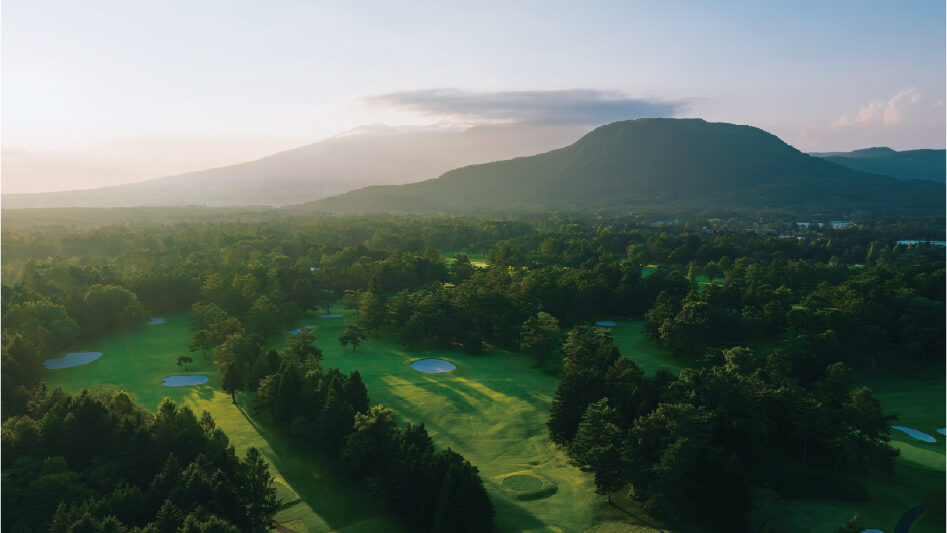
晴山ゴルフ場
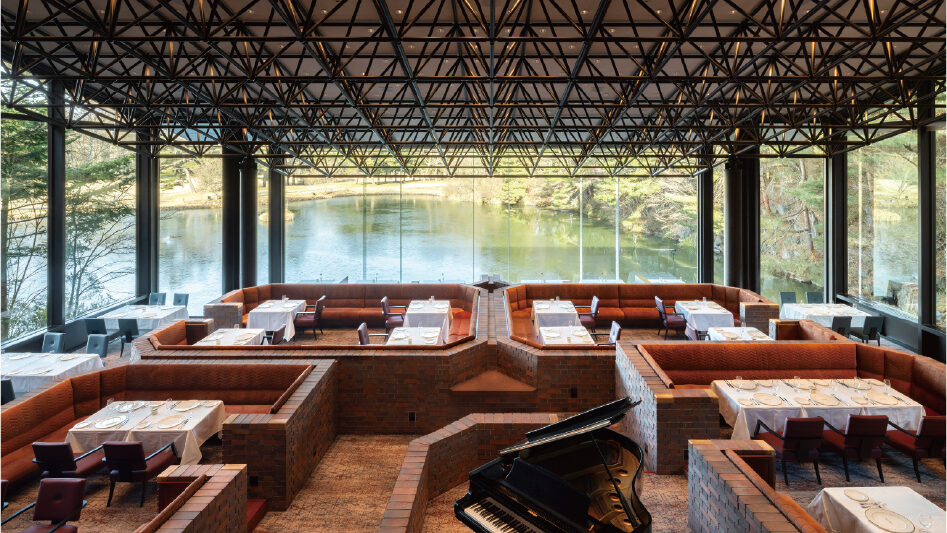
ダイニングルーム ボーセジュール
広告


